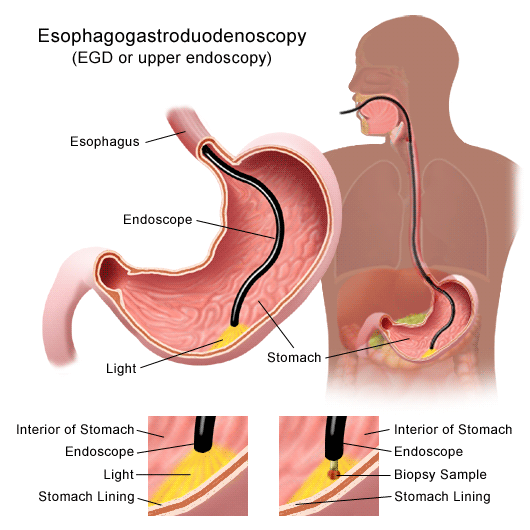|
Esophagogastroduodenoscopy (EGD):
An Overview
Esophagogastroduodenoscopy is a diagnostic
endoscopic procedure that visualizes the upper
part of the gastrointestinal tract up to the
duodenum. It is considered a minimally invasive
procedure since it does not require an incision
into one of the major body cavities and does not
require any significant recovery after the
procedure (unless sedation or anesthesia has
been used). A sore throat is also common.
The
Procedure
The
patient is kept NPO (Nil per os) or NBM (Nothing
By Mouth) that is, told not to eat, for at least
4-6 hours before the procedure. Most patients
tolerate the procedure with only topical
anaesthesia of the oropharynx using lidocaine
spray. However, some patients may need sedation
and the very anxious/agitated patient may even
need a general anaesthetic. Informed consent is
obtained before the procedure. The main risks
are bleeding and perforation. The risk is
increased when a biopsy or other intervention is
performed.
The patient lies on his/her left side with the
head resting comfortably on a pillow. A
mouth-guard is placed between the teeth to
prevent the patient from biting on the
endoscope. The endoscope is then passed over the
tongue and into the oropharynx. This is the most
uncomfortable stage for the patient. Quick and
gentle manipulation under vision guides the
endoscope into the esophagus. The endoscope is
gradually advanced down the esophagus making
note of any pathology. Excessive insufflation of
the stomach is avoided at this stage. The
endoscope is quickly passed through the stomach
and through the pylorus to examine the first and
second parts of the duodenum. Once this has been
completed, the endoscope is withdrawn into the
stomach and a more thorough examination is
performed including a J-maneuver. This involves
retroflexing the tip of the scope so it
resembles a 'J' shape in order to examine the
fundus and gastroesophageal junction. Any
additional procedures are performed at this
stage. The air in the stomach is aspirated
before removing the endoscope. Still photographs
can be made during the procedure and later shown
to the patient to help explain any findings
|